One of the most frequently asked questions I receive is about white chocolate; namely "is white chocolate real chocolate?" To this query I always give two versions of yes: a legal one and an opinion-based one.
But as the definition of white chocolate is stretched and obscured, and questioned at every turn & in every region of the world, I've been forced to confront how malleable my own limits are. For example, there are only two ingredients legally required to make white chocolate: cocoa butter and dairy milk.
But most of the sites out there are mentioning sugar, vanilla, and lecithin as required ingredients; that's like saying that salad isn't salad unless it's got ranch dressing on top. Just because something is typically prepared one way doesn't mean that that's the only way; just look at ruby chocolate.
The next wave of white chocolate is far from white. So this month we're diving into the reality of white chocolate, including its definition, future, and best qualities.

Jump to:
What is White Chocolate, Legally?
What you may not realize about chocolate is that it has a legal definition, or rather, legal standards which must be met before a product can be called "chocolate." Each of the three (or four) types of chocolate has a different legal standard for cacao content and dairy content.
All of these standards vary between countries and regions (the EU versus Canada versus New Zealand, for example). So first, let's look at what white is chocolate made of. According to the American FDA, to legally be marketed as "white chocolate," a product must contain at least 20% cocoa fat, at least 3.5% milk fat, and at least 14% total milk solids.
It also can't consist of more than 55% nutritive carbohydrate sweetener. In translation, a theoretical American white chocolate bar could legally contain 55% sugar, 20% cocoa butter, 17.5% milk powder, and 7.5% something else.
That last percentage is usually a combination of so-called "fillers," such as lecithin, flavorings, whey products, and often, more powdered milk. There are no cocoa solids or chocolate liquor in white chocolate; it's all pressed cocoa butter.
In the equation of white chocolate ingredients, cocoa butter is the expensive part, since it has high value in the cosmetics industry. So in mass-produced bars, like Cadbury white chocolate, when they formulate them for the US market, they use the bare minimum percentage of cacao that allows them to call these bars white chocolate.
When they don't meet these minimums, however, it doesn't mean that products are reformulated or pulled off the shelves; they're simply renamed. See: Hershey's Special Dark, Caramelized Creme Hershey's Gold, and Hershey's Cookie's 'N' Creme.
The replacement of the word 'chocolate' with the brand 'Hershey's' and the implication of dairy with the use of 'creme' is an appalling misrepresentation if you actually look at the ingredients list: zero cocoa solids and zero cocoa butter.

Quick Rant on Hersheys White Chocolate
If I didn't know any better, I'd assume that Hershey's had gotten out of the chocolate-producing industry altogether. Just as an example, let's look at their Premier White Vanilla 1M Baking Chips, whose ingredients are: sugar; skim milk; hydrogenated vegetable oil [palm kernel oil; soybean oil; palm oil]; palm kernel oil; contains 2% or less of: artificial flavor; lecithin (soy); salt.
The chips don't contain a trace of cacao beans and aren't legally declared to be chocolate, yet all the comments on the product page are about how great of a sweet white chocolate they are. So this clash begs the question— is Hershey's white chocolate really white chocolate, when it contains no cocoa whatsoever?
Well, no, no it's not. But since Hershey's never outright calls many of these products chocolate on their wrappers, they're within their legal rights to ruin the good name of white chocolate for generations of people around the world.
Even Cadbury white chocolate comes into question when looking at its ingredients outside of the EU and North America. Around the world, white chocolate has become synonymous with a sweet milky flavor that tastes more like vanilla extract than like any cocoa bean in existence.
If you've ever cooked anything, you'll learn quickly that the fat carries the flavor, and this is also true with cacao. Cocoa butter has a natural chocolaty aroma that's chemically removed before making mass-market white chocolate, but which has come to be celebrated in craft white chocolates.
The problem is that most mass-market companies like Cadbury and Mondelez and Hershey's use such low quality cacao that they need to almost burn it to standardize the flavor, and burnt-smelling cocoa butter won't do anything good for their milky flavor.
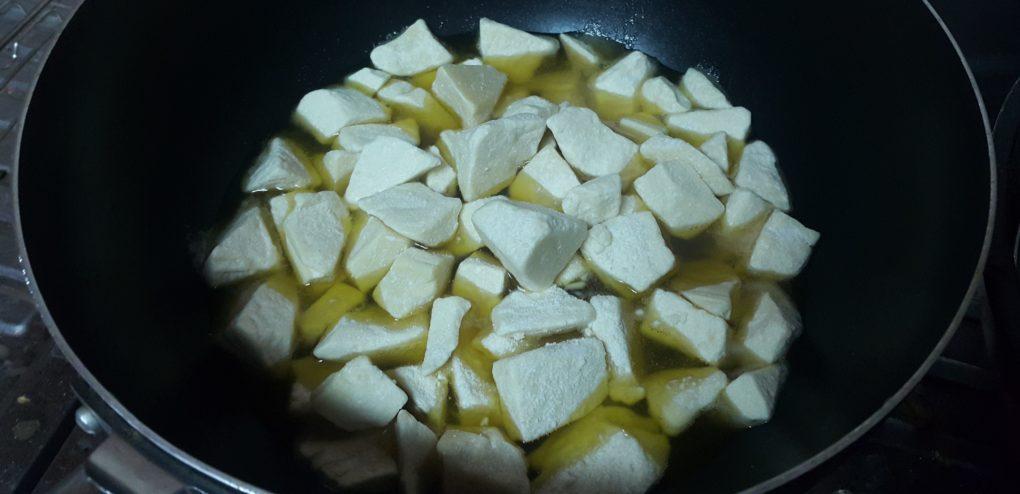
Is White Chocolate Vegan?
This is another question I get a lot, and the short answer is that no, white chocolate isn't vegan. There are certainly vegan white chocolate options out there; they just can't call their products "chocolate." That's where the rub comes in for eco-conscious and/or plant-based consumers.
Because the legal definition for both white chocolate and milk chocolate includes the addition of a certain percentage of dairy, anything made with a milk alternative is not legally white chocolate.
So while established candy corporations use word association to imply chocolate-like tendencies, vegan craft chocolate companies are making products with twice the cacao butter, half the sugar, and none of the milk, and their lack of name recognition forces them to get even more creative with naming.
Luckily, as Julia Zotter said in the milk alternative episode of my podcast, these smaller companies do have cards they can play.
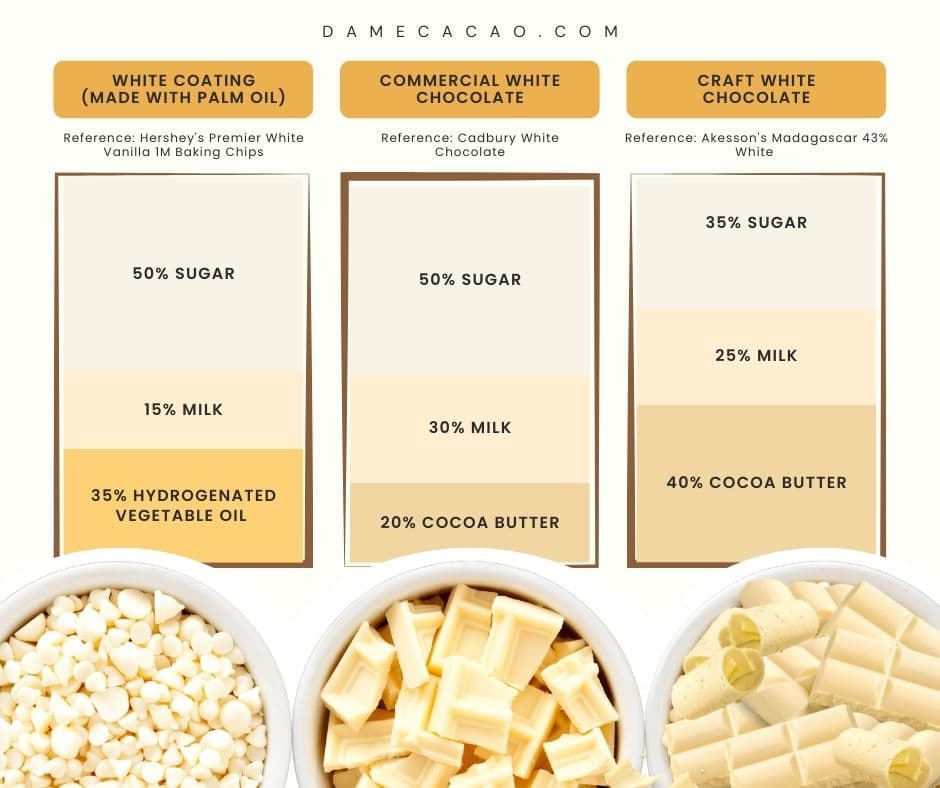
Not only are their ingredients lists full of real foods, but they tend to source ethically-farmed cacao, well-processed and purchased at a premium. Due to their size, they can pivot towards or away from certain ingredients when it makes sense, and they aren't obliged to defend their choices to shareholders.
They can also publicize their partnerships with cacao farmers, rather than affirming a commitment to ethics only when it's good publicity. For delicious vegan white chocolate, might I suggest makers like Solkiki Chocolate, Charm School Chocolate, and Pascha Chocolate.
The latter is not a fully vegan company, but with great allergen-free vegan chocolates. Each of these companies offers a great plant-based white chocolate, most of them made with coconut milk powder in place of dairy.
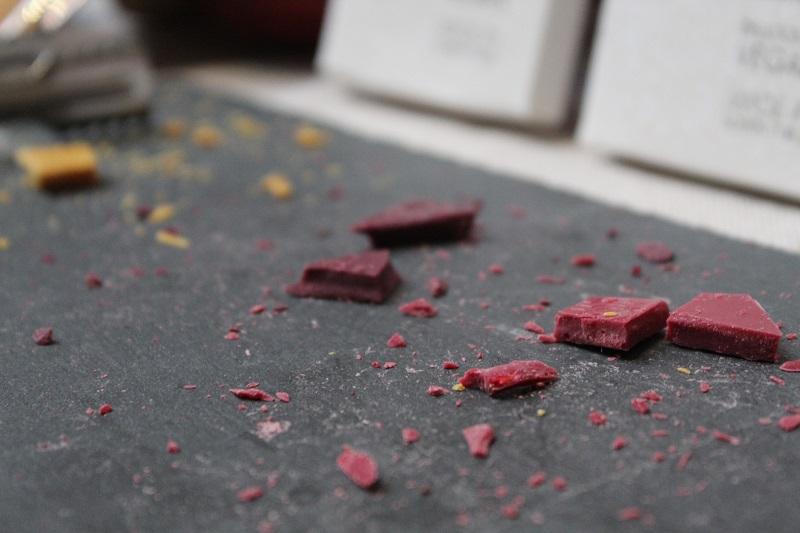
How Bad is White Chocolate For You?
I'm not gonna lie to you and declare white chocolate to be the next superfood, but the news isn't all bad on that front. As long as you're eating real white chocolate, with no weird oils or flavoring, there are only three factors to take into account: cocoa butter, sugar, and milk powder (sometimes soy lecithin).
While we know that refined sugar isn't good for us, milk powder is a mixed bag, with some calcium & potassium and a small amount of protein. The main nutritional consideration in craft white chocolate, however, is the cocoa butter.
There are three main types of fat which make up cocoa butter: stearic, palmitic, and oleic fatty acids; there's also a small amount of linoleic acid. Palmitic acid is known to raise LDL (unhealthy) cholesterol levels, but only makes up around 25% of cocoa butter, whereas all three of the other fatty acids which make up cocoa butter actually lower those unhealthy cholesterol levels.
So you could say that cocoa butter self-regulates itself, insofar as affecting the heart. The unhealthy aspects of white chocolate are basically the added sugars, both the refined sugar and the lactose, as the high caloric value of the product.
There aren't many health benefits to white chocolate, but you can find less unhealthy white chocolates by looking for cocoa percentages of 40% or higher (which is actually incredibly rare), and looking for bars which replaces some of the typical refined sugar with a different sweetener.
You can tell just by looking at the nutrition facts of the bar what percent cocoa butter and what percent sugar are inside— just divide the grams of sugar per serving by the total number of grams in a serving— and after that, enjoy in moderation.

Where to Find "Real" White Chocolate
While I always advocate lobbying your local craft chocolate maker for any cacao-based products you desire, I know most makers are too small to expand with any haste. Therefore I think it's important to be aware of where to buy craft chocolate online and how to identify the worth of any random white chocolate bars you may find out in the wild.
The following are my best tips for finding real white chocolate anywhere you go:
- Remember that the only ingredients needed in white chocolate are cocoa butter (also called cacao butter), sugar, and milk. Some bars will be made with a milk alternative, but either way, a plain white chocolate bar shouldn't be made up of more than five ingredients, none of them being added oils.
- Avoid anything made with hydrogenated oil, palm oil, or natural or artificial flavors.
- Vanilla and soy (or sunflower) lecithin are the main additives in white chocolate. While not necessarily bad, they are questionable choices if a maker is already using high quality cocoa butter. So even though lecithins and vanilla aren't really factors or indicators of good white chocolate, I'd more closely analyze plain white chocolates which contain them.
- Look for a pale yellow or ivory color in the chocolate; cocoa butter naturally has a slight yellow tint to it, so if the chocolate is pure white, then it was chemically treated in some way.
- There should be a mild chocolaty aroma to the product, thanks to the good flavor development of the fat during proper post-harvest processing.
- Expect to pay at least $4 a bar for good quality white chocolate, and even more if it's a single origin craft chocolate.
So what is the best white chocolate out there? Well, that's for you to decide. Some amazing ones I always go back to are made by companies like Akesson's Chocolate, Pump Street Chocolate, Omnom Chocolate, SoMA Chocolate, Zotter Chocolate, and Monsoon Chocolate.
I encourage you to explore what's out there, and don't be deterred by bad white chocolates you may have had in the past. Also, check out caramelized white chocolate.
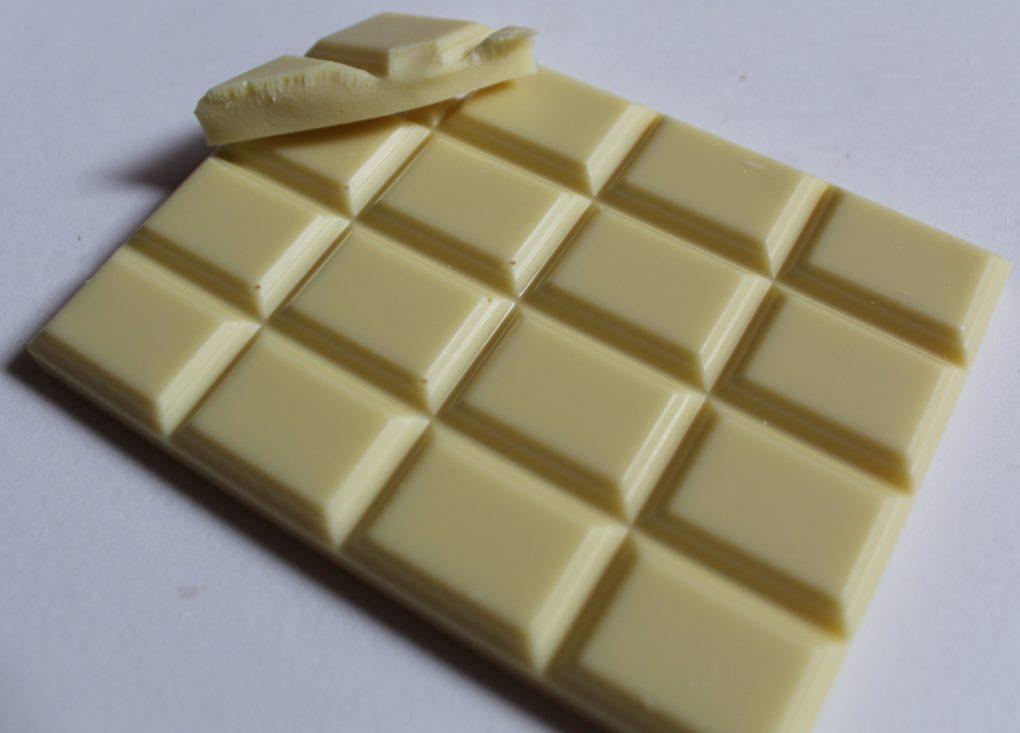
The Future of White Chocolate
Honestly, this isn't really a question I've been asked much, but if you've read this far, then it's probably of interest to you. White chocolate, as you've now read, is more than just a sweet vanilla-scented confection; it's got real substance and room to grow.
From what I've witnessed over the last several years, the future of white chocolate lies in the hands of craft chocolate makers, not as the only producers of fine white chocolate, but as the tastemakers for where the flavors are headed.
Each of the three main variables at play— cocoa butter, milk powder, and sugar— can be manipulated in some way to yield a unique result. Replacing the cocoa butter in any way removes the only ingredient which gives credence to us calling white chocolate "chocolate," but it can still be altered in percentage, origin, conche time, etc.
When it comes to milk powders there are even more variables at play, including plant-based milk alternatives like oat or coconut, and less common powdered dairy, like powdered cream cheese or powdered buttermilk.
Traditional refined sugars are slowly being swapped out for lower glycemic impact sweeteners like date sugar, erythritol, and monk fruit. But now there are also makers using fruit powders in place of either sugar or milk, and a bevy of unique regional inclusions (added flavoring elements) finding their place in homemade white chocolate.
These days it's become rather popular to learn how to make white chocolate at home. But even if you haven't yet hopped on the band wagon of home chocolate making, sugar free white chocolate, and vegan alternatives to everything, just know that white chocolate is not only real chocolate, but it can also be real delicious.
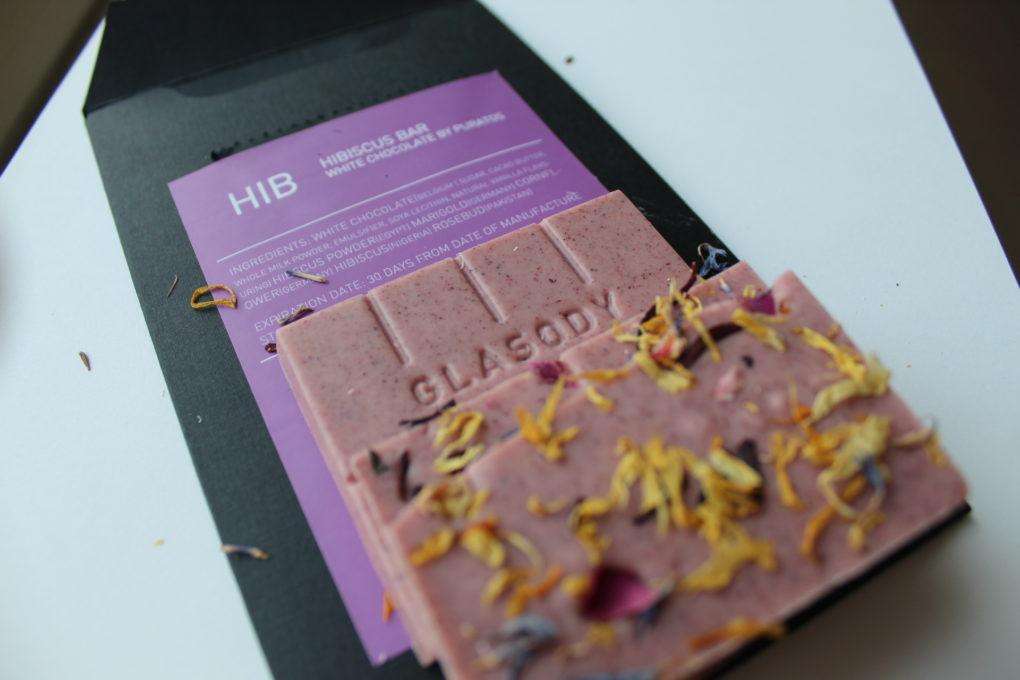
White Chocolate FAQ
The exact date when white was chocolate invented seems to have been lost to history, but the first commercial white chocolate was released by Switzerland's Nestle Company in 1936. These days, white chocolate is produced in factories around the world, with Nestle still leading global sales.
While white chocolate legally must contain dairy, many craft chocolate makers now offer vegan white chocolates make with milk alternatives, most popularly coconut, oat, or soy milk.
Yes, white chocolate can go bad if the milk powder inside goes off, or even if (usually after many years) the cocoa butter itself goes rancid. Expired white chocolate will no longer smell sweet and creamy but more like sour milk or cheese.
Most white chocolate contains only the legal minimum of 20% cocoa butter, meaning that the rest of the mass is made up of sugar and high-fat milk powder. All that sugar and fat is tightly-packed together, so it's easy to overeat it, which is really what makes white chocolate bad for you.
Many people say white chocolate is not chocolate because it doesn't contain cocoa solids, but on a legal level, white chocolate is considered chocolate. However, white chocolate without cocoa butter is not legally chocolate in regions which regulate the legal use of the word "chocolate," such as the US, Canada, and the EU.
No, white chocolate has no caffeine. But then, can white chocolate cause migraines like dark chocolate can? The answer is technically yes, but only for those with a sugar intolerance or a histamine sensitivity.

















Janice King
If the cocoa bean is grown in areas where heavy metals are found in the soil, why would cocoa butter not be contaminated with those same metals as we are told that chocolate has.
Max
This is because the heavy metals absorbed by the roots of older cacao trees deposit the metals primarily in the solids of the cacao beans, which make up half of the beans (the other half being fat). And as for the sensationalized study you're referring to, it used the Prop 65 basis for heavy metals, whose maximum is less than 20% of the strictest European standards (the USA doesn't have any federal limits published). It also didn't give any of the data on other foods— chocolate consumption makes up a miniscule portion, well under 5% of the average American's daily cadmium intake— if you look at this study, most dietary cadmium comes from grains, starches, leafy greens, and nuts. This is also controlling for cigarette smoking and working environmental exposure, which are the two most common circumstances which majorly up one's cadmium exposure.
The bottom line is, chocolate is not something people should worry about when it comes to heavy metal exposure.
Marie Hartwell
I love this article; it’s informative and funny.
Max
Thanks, Marie!
Johnny Cheddar
@Max, I like it too